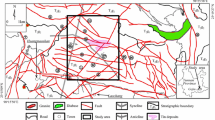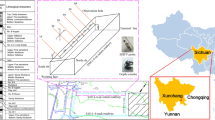Abstract
Identification of homogeneous region boundaries in a fractured rock mass is the basis of statistics and modeling of discontinuities. In engineering practice, an objective division can be obtained by adopting the major influential factors as indicators and the optimal approach as a tool. For discontinuities in Beishan, a main candidate site for Chinese high-level radioactive waste (HLW) repository, pretreatment techniques (e.g., sampling window truncation, sampling bias correction and block-net variation correction) were used to deal with field data. Programming was then applied to realize homogeneous region division via several methods (e.g., the improved Miller’s method, Mahtab and Yegulalp’s method, and correlation coefficient method). This study preliminarily examined these methods’ distinguishing capability, applicability, and limitations. Results showed that the applicability of the correlation coefficient method as well as the Mahtab and Yegulalp’s method was weak; the improved Miller’s method appeared most satisfactory, especially with a large-area strategy (34 blocks). Finally, two statistical homogeneous regions were obtained by applying the optimal approach to the Jijicao block. Findings can offer guidance for subsequent research on discrete fracture network (DFN) modeling and seepage path simulation, which is important for the prediction and evaluation of radionuclide migration in rock masses.




















Similar content being viewed by others
Data availability
Some or all data, models, or code generated or used during the study are available by contacting the corresponding author at Liang Guo (e-mail: glxzw@swpu.edu.cn).
Abbreviations
- e ij :
-
is the expected frequency of poles in unit ij
- f ij :
-
is the observation frequency of poles in unit ij
- Xi (i = 1, 2, 3, n):
-
is the observation frequency in blocks of region 1
- Yi (i = 1, 2, 3, n):
-
is the observation frequency in blocks of region 2
- R i :
-
is the total number of poles observed in row i
- C j :
-
is the total number of poles observed in column j
- N :
-
is the total number of poles observed
- D :
-
is the random density
- TCF :
-
is the correction coefficient used in the sampling line
- c :
-
is the fractional area of a block versus the upper-hemisphere
- k :
-
is the minimum integer
- m :
-
is the average pole number of one block in the sample, m = qc
- n :
-
is the number of blocks selected for use on the lower-hemisphere, and the value in the correlation coefficient method is 100
- p :
-
is the probability of random density D
- q :
-
is the total number of poles in the sample
- α :
-
is an assigned low probability
- γ :
-
is the Pearson correlation coefficient
- δ :
-
is the acute angle between the sampling line and the fractures normal
- αn and βn :
-
are the trend and plunge of the fracture’s normal vector, respectively
- αs and βs :
-
are the trend and plunge of the sample line, respectively
References
Ayan C, Colley N, Cowan G, Ezekwe E, Wannell M, Goode P, Halford F, Joseph J, Mongini A, Obondoko G, Pop J (1994) Measuring permeability anisotropy: the latest approach. Oilfield Rev 6(4):24–35
Baecher GB, Lanney NA (1978) Trace length biases in joint surveys: proceedings of the 19th U.S. Symp Rock Mech v1:56–65. https://doi.org/10.1016/0148-9062(79)90799-X
Cruden DM (1977) Describing the size of discontinuities. Int J Rock Mech Min Sci Geomech Abstr 14(3):133–137. https://doi.org/10.1016/0148-9062(77)90004-3
Einstein HH, Baecher GB (1983) Probabilistic and statistical methods in engineering geology, specific methods and examples part I: exploration. Rock Mech Rock Eng 16(1):39–72. https://doi.org/10.1007/BF01030217
Eivazy H, Esmaieli K, Jean R (2017) Modelling geomechanical heterogeneity of rock masses using direct and indirect geostatistical conditional simulation methods. Rock Mech Rock Eng 50(12):3175–3195. https://doi.org/10.1007/s00603-017-1293-0
Escuder VJ, Carbonell R, Jurado MJ, Mart D, Perez-Estaun A (2001) Two-dimensional geostatistical modeling and prediction of the fracture system in the Albala granitic pluton, SW Iberian massif, Spain. J Struct Geol 23(12):2011–2023. https://doi.org/10.1016/S0191-8141(01)00026-8
Feder J (1988) Fractals, plenum press. London, New York
Guo L, Li XZ, Zhou YY, Zhang YS (2015) Generation and verification of three-dimensional network of fractured rock masses stochastic discontinuities based on digitalization. Environ Earth Sci 73(11):7075–7088. https://doi.org/10.1007/s12665-015-4175-3
Guo L, Hu XW, Wu LZ, Li XZ, Ma HS (2018) Simulation of fluid flow in fractured rocks based on the discrete fracture network model optimized by measured information. Int J Geomech 18(10):1532–3641. https://doi.org/10.1061/(ASCE)GM.1943-5622.0001270
Hamidi JK, Shahriar K, Rezai B, Bejari H (2010) Application of fuzzy set theory to rock engineering classification systems: an illustration of the rock mass excavability index. Rock Mech Rock Eng 43(3):335–350. https://doi.org/10.1007/s00603-009-0029-1
Hoek E, Bray JW (1981) Rock slope engineering. Institution of Mining and Metallurgy, London
Huang N, Liu RC, Jiang YJ, Cheng YF, Li B (2019) Shear-flow coupling characteristics of a three-dimensional discrete fracture network-fault model considering stress-induced aperture variations. J Hydrol 571:416–424. https://doi.org/10.1016/j.jhydrol.2019.01.068
Hudson J, Harrison J (1997) Engineering rock mechanics: an introduction to the principles. Elsevier, Amsterdam
Ji YJ, Wang J, Huang LK (2015) Analysis on inflowing of the injecting water in faulted formation. Adv Mech Eng 7(6):1–10. https://doi.org/10.1177/1687814015590294
Jimenez-Rodriguez R, Sitar N (2006) A spectral method for clustering of rock discontinuity sets. Int J Rock Mech Min 43(7):1052–1061. https://doi.org/10.1016/j.ijrmms.2006.02.003
Kulatilake PHSW, Wu TH (1984a) Sampling bias on orientation of discontinuities. Rock Mech Rock Eng 17(4):243–254. https://doi.org/10.1007/BF01032337
Kulatilake PHSW, Wu TH (1984b) Estimation of mean trace length of discontinuities. Rock Mech Rock Eng 17(4):215–232. https://doi.org/10.1007/BF01032335
Kulatilake PHSW, Wathugala DN, Poulton M, Stephansson O (1990a) Analysis of structural homogeneity of rock masses. Eng Geol 29(3):195–211. https://doi.org/10.1016/0013-7952(90)90050-B
Kulatilake PHSW, Wu TH, Wathugala DN (1990b) Probabilistic modelling of joint orientation. Int J Numer Anal Met 14(5):325–350. https://doi.org/10.1002/nag.1610140503
Kulatilake PHSW, Chen J, Teng J, Shufan SF, Pan G (1996) Discontinuity geometry characterization in a tunnel close to the proposed permanent ship-lock area of the three gorges dam site in China. Int J Rock Mech Min Sci Geomech Abstr 33(3):255–277. https://doi.org/10.1016/0148-9062(95)00060-7
Kulatilake PHSW, Fiedler R, Panda B (1997) Box fractal dimension as a measure of statistical homogeneity of jointed rock masses. Eng Geol 48(3–4):217–229. https://doi.org/10.1016/S0013-7952(97)00045-8
Lancaster HO (1969) The chi-squared distribution. Wiley, New York
LaPointe PR, Hudson JA (1985) Characterization and interpretation of rock mass joint patterns. Geol Soc Am Spec Pap 199:1–38. https://doi.org/10.1130/SPE199-p1
Li YY, Wang Q, Chen JP, Han LL, Song SY (2014) Identification of structural domain boundaries at the Songta dam site based on non-parametric tests. Int J Rock Mech Min Sci 70:177–184. https://doi.org/10.1016/j.ijrmms.2014.04.018
Li YY, Wang Q, Chen JP, Song SY, Ruan YK, Zhang Q (2015) A multivariate technique for evaluating the statistical homogeneity of jointed rock masses. Rock Mech Rock Eng 48(5):1821–1831. https://doi.org/10.1007/s00603-014-0678-6
Louis L, David C, Metz V, Robion P, Menendez B, Kissel C (2005) Microstructural control on the anisotropy of the elastic and transport properties in un-deformed sandstones. Int J Rock Mech Min Sci 42(7–8):911–923. https://doi.org/10.1016/j.ijrmms.2005.05.004
Mah J, Samson C, Mckinnon SD (2011) 3D laser imaging for joint orientation analysis. Int J Rock Mech Min Sci 48(6):932–941. https://doi.org/10.1016/j.ijrmms.2011.04.010
Mahtab MA, Yegulalp TM (1984) Similarity test for grouping orientation data in rock mechanics. Proc 25th Symposium on Rock Mechanics: Rock Mechanics in Productivity and Protection. Evanston IL USA Society of Mining Engineers of AIME, New York, p 25-27
Mahtab MA, Bolstad DD, Alldredge JR, Shanley RJ (1972) Analysis of fracture orientations for input to structural models of discontinuous rock. Bureau of Mines 1–76
Martin MW, Tannant DD (2004) A technique for identifying structural domain boundaries at the EKATI diamond mine. Eng Geol 74(3–4):247–264. https://doi.org/10.1016/j.enggeo.2004.04.001
Mauldou M (1998) Estimating mean fracture trace length and density from observations in convex windows. Rock Mech Rock Eng 31:201–216. https://doi.org/10.1007/s006030050021
Miller SM (1983) A statistical method to evaluate homogeneity of structural populations. Math Geol 15(2):317–328. https://doi.org/10.1007/BF01036073
Munier R (2004) Statistical analysis of fracture data adapted for modeling discrete fracture networks-version 2. Stockholm SKB Rapport R-04-66:20-23
Nicholas DE, Sims DB (2000) Collecting and using geologic structure data for slope design. In: Hustrulid WA, McCarter MK, Dirk J (eds) Slope stability in surface mining. Society for Mining Metallurgy Exploration Inc, Littleton, pp 11–26
Oliveira R, Graca JC (1987) In-situ testing of rocks. Butterworth-Heinemann, London
Pahl PJ (1981) Estimating the mean length of discontinuity trace. Int J Rock Mech Min Sci Geomech Abstr 18(5):221–228. https://doi.org/10.1016/0148-9062(81)90025-5
Piteau DR, Russell L (1971) Cumulative sums technique: a new approach to analyzing joints in rock. In: Proceedings of the 13th US symposium on rock mechanics, Urbana 1-29
Priest SD (1993) Discontinuity analysis for rock engineering. Springer, Dordrecht
Priest SD, Hudson JA (1981) Estimation of discontinuity spacing and trace length using scanline surveys. Int J Rock Mech Min Sci Geomech Abstr 18(3):183–197. https://doi.org/10.1016/0148-9062(81)90973-6
Rohrbaugh MB, Dunne WM, Mauldon M, Menezes DF, Bezerra FH, Balsamo F, Samsu A, Cruden AR, Micklethwaite S, Czertowicz TA, Takeshita T, Arai S (2002) Estimating fracture trace intensity, density, and mean length using circular scan lines and windows. AAPG Bull 86(12):2089–2104. https://doi.org/10.1306/61EEDE0E-173E-11D7-8645000102C1865D
Song SY, Wang Q, Chen JP, Li YY, Zhang Q, Cao C (2015) A multivariate method for identifying structural domain boundaries in a rock mass. Bull Eng Geol Environ 74(4):1407–1418. https://doi.org/10.1007/s10064-014--0686-5
Terzaghi RD (1965) Sources of error in joint surveys. Geotechnique 15(3):287–304. https://doi.org/10.1680/geot.1965.15.3.287
Um JG, Noh YH, Choi Y (2015) A random cantor set as a measure of the statistical homogeneity of fractured rock masses. Geosyst Eng 18(2):117–125. https://doi.org/10.1080/12269328.2015.1021056
Wang J (2014) On area-specific underground research laboratory for geological disposal of high-level radioactive waste in China. J Rock Mech Geotech Eng 6(2):99–104. https://doi.org/10.1016/j.jrmge.2014.01.002
Wathugala DN, Kulatilake PHSW, Wathugala GW, Stephansson O (1990) A general procedure to correct sampling bias on joint orientation using a vector approach. Comput Geotech 10(1):1–31. https://doi.org/10.1016/0266-352X(90)90006-H
Zhang W, Zhao QH, Huang RQ, Chen JP, Xue YG, Xu PH (2016) Identification of structural domains considering the size effect of rock mass discontinuities: a case study of an underground excavation in Baihetan dam, China. Tunn Undergr Space Technol 51:75–83. https://doi.org/10.1016/j.tust.2015.10.026
Acknowledgments
The field geological survey of this work has been strongly supported by the Beijing Research Institute of Uranium Geology, and I sincerely thank them for the great support.
Funding
This work was financially supported by National Natural Science Foundation of China (No.41602290, No.41702340), the Open Fund of State Key Laboratory of Geohazard Prevention and Geoenvironment Protection (Chengdu University of Technology, No. SKLGP2017K012), Sichuan Science and Technology Project (No.2019YJ0349), and Research project of Sichuan Mineral Resources Research Center (No. SCKCZY2019-YB001).
Author information
Authors and Affiliations
Corresponding author
Rights and permissions
About this article
Cite this article
Guo, L., Wu, L., Zhang, J. et al. Identification of homogeneous region boundaries of fractured rock masses in candidate sites for Chinese HLW repository. Bull Eng Geol Environ 79, 4221–4243 (2020). https://doi.org/10.1007/s10064-020-01837-4
Received:
Accepted:
Published:
Issue Date:
DOI: https://doi.org/10.1007/s10064-020-01837-4




